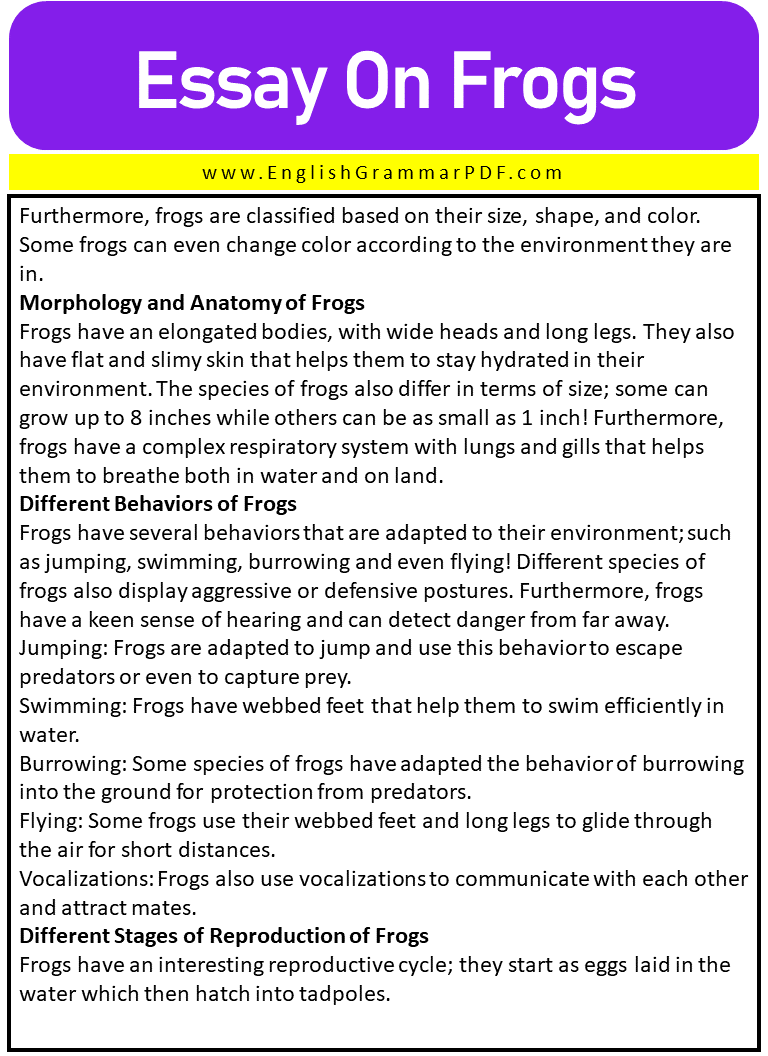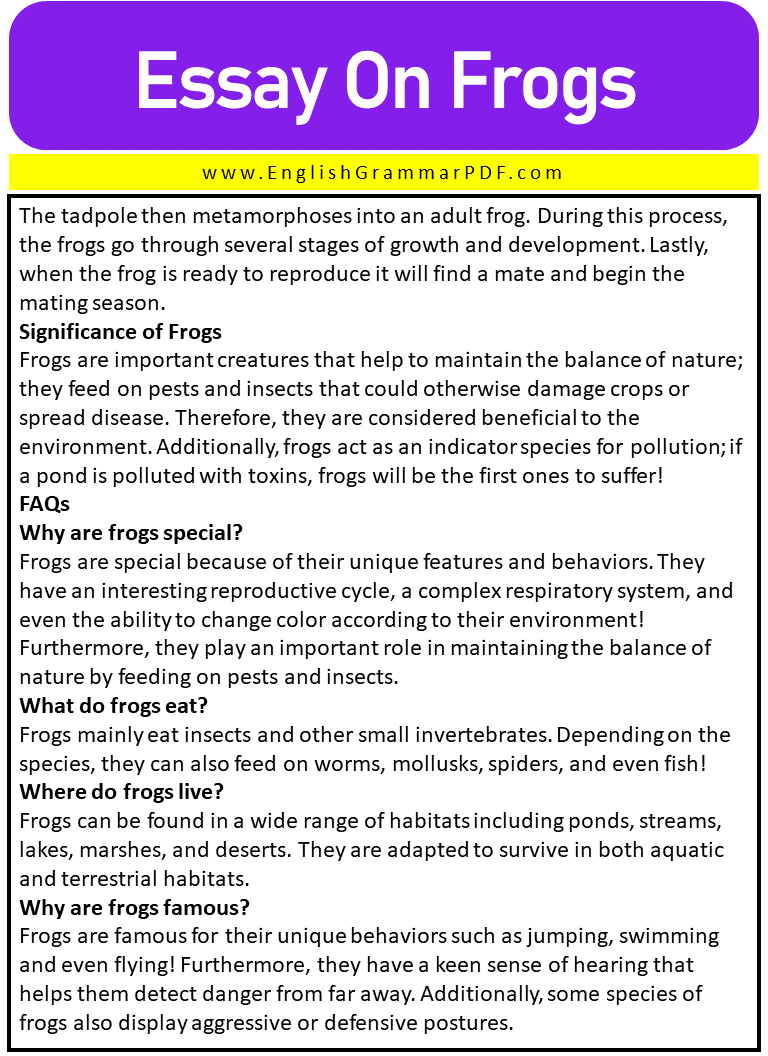Essay On Frogs
Outline of Essay:
- Introduction
- Habitats of Frogs
- Classification of Frogs
- Morphology and Anatomy of Frogs
- Different Behaviors of Frogs
- Different Stages of Reproduction of Frogs
- Significance of Frogs
- FAQ’s
Introduction
Frogs are amphibians with several distinct characteristics. These amphibians belong to the order Anura and come in a variety of sizes, shapes, and colors. They display an impressive level of diversity and occupy almost every ecosystem around the world; from deserts to rainforests, they can be found everywhere! Frogs play an important role in maintaining the balance of nature and have several unique features that make them fascinating creatures.
Habitats of Frogs
Frogs inhabit a wide range of habitats including, ponds, streams, lakes, marshes, and even desserts! They occupy different areas depending on their species; for example, some frogs prefer to live in wet tropical forests while others live in the desert. Frogs are also adapted to survive in both aquatic and terrestrial habitats, hence they can be found almost anywhere.
Classification of Frogs
Frogs belong to a group called Anura, which is composed of more than 4,800 species! This group is further divided into three main families; Ranidae, Hylidae, and Leptodactylidae. Each of these families contains different species of frog, with some having more than one hundred species! Furthermore, frogs are classified based on their size, shape, and color. Some frogs can even change color according to the environment they are in.
Morphology and Anatomy of Frogs
Frogs have an elongated bodies, with wide heads and long legs. They also have flat and slimy skin that helps them to stay hydrated in their environment. The species of frogs also differ in terms of size; some can grow up to 8 inches while others can be as small as 1 inch! Furthermore, frogs have a complex respiratory system with lungs and gills that helps them to breathe both in water and on land.
Different Behaviors of Frogs
Frogs have several behaviors that are adapted to their environment; such as jumping, swimming, burrowing and even flying! Different species of frogs also display aggressive or defensive postures. Furthermore, frogs have a keen sense of hearing and can detect danger from far away.
Jumping: Frogs are adapted to jump and use this behavior to escape predators or even to capture prey.
Swimming: Frogs have webbed feet that help them to swim efficiently in water.
Burrowing: Some species of frogs have adapted the behavior of burrowing into the ground for protection from predators.
Flying: Some frogs use their webbed feet and long legs to glide through the air for short distances.
Vocalizations: Frogs also use vocalizations to communicate with each other and attract mates.
Different Stages of Reproduction of Frogs
Frogs have an interesting reproductive cycle; they start as eggs laid in the water which then hatch into tadpoles. The tadpole then metamorphoses into an adult frog. During this process, the frogs go through several stages of growth and development. Lastly, when the frog is ready to reproduce it will find a mate and begin the mating season.
Significance of Frogs
Frogs are important creatures that help to maintain the balance of nature; they feed on pests and insects that could otherwise damage crops or spread disease. Therefore, they are considered beneficial to the environment. Additionally, frogs act as an indicator species for pollution; if a pond is polluted with toxins, frogs will be the first ones to suffer!
FAQs
Why are frogs special?
Frogs are special because of their unique features and behaviors. They have an interesting reproductive cycle, a complex respiratory system, and even the ability to change color according to their environment! Furthermore, they play an important role in maintaining the balance of nature by feeding on pests and insects.
What do frogs eat?
Frogs mainly eat insects and other small invertebrates. Depending on the species, they can also feed on worms, mollusks, spiders, and even fish!
Where do frogs live?
Frogs can be found in a wide range of habitats including ponds, streams, lakes, marshes, and deserts. They are adapted to survive in both aquatic and terrestrial habitats.
Why are frogs famous?
Frogs are famous for their unique behaviors such as jumping, swimming and even flying! Furthermore, they have a keen sense of hearing that helps them detect danger from far away. Additionally, some species of frogs also display aggressive or defensive postures. These features make them popular among people all over the world!
Download the Pdf of the Essay On Frogs



Read More Essays:


